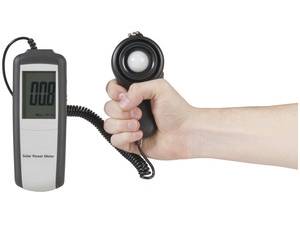Instruments for testing photovoltaic panels
I posted a few days ago about disappointing power output of my "250W" folding solar panel:
http://bkhome.org/news/201904/atem-power-250w-solar-panel-is-a-dud.html
...I only got about 120W out of it.
What I want to do is get setup to do more precise measurements,
including taking into account the intensity of the sun and the ambient
and cell temperatures. To achieve this, I needed to purchase some
measuring instruments, that I have done.
Solar power meter
I hunted online to find out if any local store (in Perth, Western
Australia) has one of these, and at a reasonable price. Found this, at a
clearance price of AU$99.95:
https://www.jaycar.com.au/solar-power-meter/p/QM1582

First impressions, quality construction, works OK.
Infra-red thermometer
Measuring solar cell temperature is difficult, as they are sandwiched
between materials both in front and back. I decided to use an infra-red
non-contact thermometer, and bought this one, AU$34.95, from Altronics:
https://www.altronics.com.au/p/q1282a-pocket-infra-red-thermometer-non-contact/

First impression, easy to use.
There is going to be a temperature gradient from the cells to back
surface of the panel. If the thermometer is used to measure back
temperature, then I read somewhere that very roughly the cell temp will
be 7°C higher.
I also read somewhere, that if the thermometer is used at the front
of the panel, at a steep angle, not perpendicular, it can get an IR
reading direct from the cell. That remains to be seen.
There is another approach to testing. Instead of letting the panel
warm up in the sun, keep it in shade, so the cells are at ambient
temperature. When everything is connected to take a reading. move the
panel into the sun, take a reading very quickly, then move the panel
back into the shade. I saw this technique being used in a YouTube video.
However, I don't know whether this will work, as I imagine the cell
junction will get hot very quickly. I intend to play with this method.
Resistive load
One way to do a super-quick evaluation of a panel is to test
short-circuit current with a multimeter. With the multimeter on DC
current-reading setting, and being sure that the multimeter can handle
the expected current, connect it directly to the terminals in the panel
junction-box. The panel could be in shade, then bring it into the sun
and observe the current.
To obtain the peak power point, though, needs more equipment. An MPPT
regulator connected to a not-fully-charged battery would do it. If the
MPPT regulator is doing it's job, it will hunt for and find the peak
power point. Some means of measuring voltage and current will be
required.
An alternative is to use a variable resistive load. For the previous
test on the "250W" panel, I used nichrome wire, just some lengths that I
had. However, some kind of continuously-variable adjustment would be
better, to accurately locate the peak power point. Also, it would need
to be designed to handle the power dissipation.
Such a load, I am planning to build very soon.
Tags: nomad
